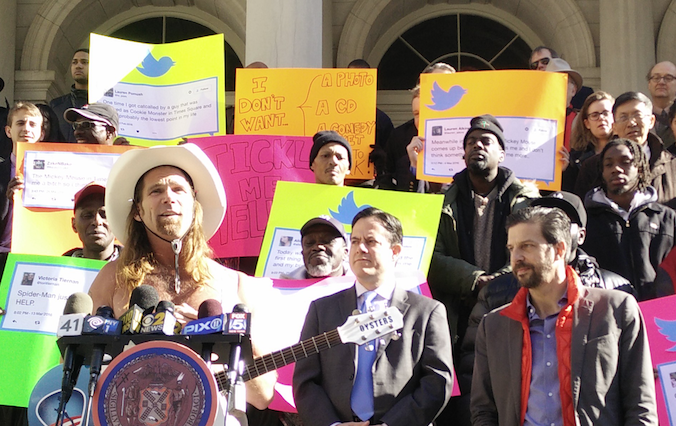
The City Council heard testimony today on Intro. 1109-A, which would give DOT authority over designating and regulating pedestrian plazas across the city. DOT has carved out nearly 70 plazas since 2008, but its jurisdiction over those plazas remains ambiguous.
This matters for a few reasons. The reason that gets all the attention is the made-for-tabloids storyline of Times Square and its desnudas and costumed hustlers. The city wants more authority to dictate where people can legally work for tips in Times Square, and investing DOT with that authority makes more sense than handing plazas over to the Parks Department, which would come with a host of drawbacks.
But it also matters for smaller plazas throughout the city, especially ones without a business improvement district to manage the space. The small organizations responsible for running these plazas often struggle to cut through the red tape involved in getting a permit for, say, an amplified performance.
The legislation does not specify new rules for plazas, but rather gives DOT the mandate to develop and implement such rules.
In Times Square, DOT intends to follow many of the recommendations from the Times Square Alliance and local electeds in last year's “Roadmap for a 21st Century Times Square” report. DOT Commissioner Polly Trottenberg said DOT will classify zones where commercial activity and vending are permitted, the intent being to keep walking routes and public seating areas clear of performers working for tips.
Speaking outside City Hall with council members and the Naked Cowboy, Times Square Alliance President Tim Tompkins said the legislation doesn't aim to stop performers, but rather to get a handle on the overly aggressive behavior of some of them. “We want a variety of activities, but we need to also recognize that for years now this has been a consistently growing problem,” he said.
While the legislation would give DOT jurisdiction over event permits in plazas, Trottenberg argued that that responsibility should remain with the mayor’s Street Activity Permit Office (SAPO). “SAPO already has the experience, expertise, and resources, and the ability to coordinate multiple agencies to manage permits and logistics for all types of events, while DOT does not,” Trottenberg said.
Despite some recent improvements, the SAPO process remains complicated and especially burdensome for community groups that manage plazas without many resources at their disposal. Completing the SAPO permitting process takes far too long for these organizations to effectively plan and execute programming in their plazas.
Laura Hansen of the Neighborhood Plaza Partnership called on SAPO to establish a plaza-specific permitting process. Speaking with Streetsblog after her testimony, she said it's important to codify recent improvements that have simplified the process and that DOT, in developing general rules of conduct for plazas, should hopefully address that. “I’m optimistic that these things will get worked out in the rules,” Hansen said.
At times today, the disproportionate focus on Times Square overshadowed the problems other plazas are dealing with, but Tompkins made sure to emphasize that the legislation would benefit all plazas in the city. “I give the Times Square Alliance a lot of credit in terms of saying, ‘This isn’t just about us, it’s about all the plazas,’” Hansen told Streetsblog.
If the legislation passes, then DOT's plaza rules must be vetted through the process outlined by the City Administrative Procedure Act, which mandates a public hearing and 30 days of public comment. The legislation will be voted on next week, and the rulemaking procedure would beging within 60 days of its passage.





